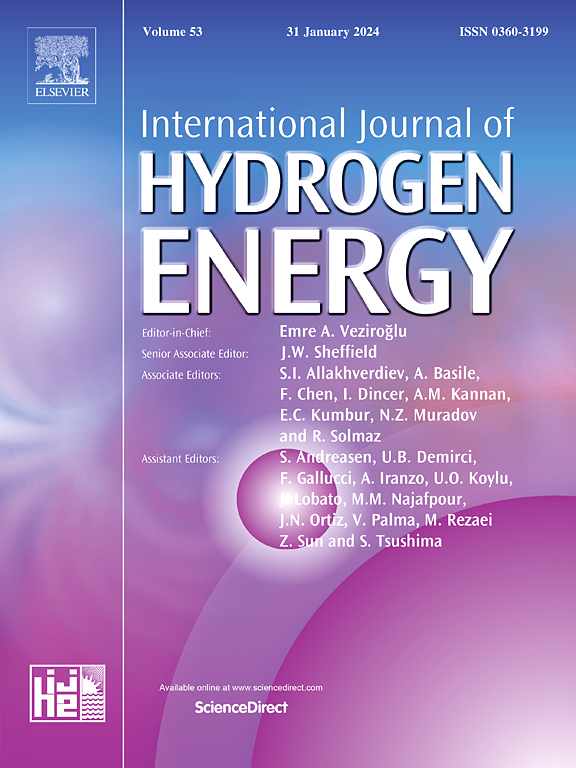Numerical analysis and optimization of photovoltaic performance of Sb2Se3 based photocathode
IF 8.1
2区 工程技术
Q1 CHEMISTRY, PHYSICAL
引用次数: 0
Abstract
Antimony selenide (Sb2Se3) based heterojunction photocathodes have recently received an increased attention, largely due to their outstanding performances for hydrogen production through photoelectrochemistry (PEC) water splitting. The PEC water splitting process encompasses both physical and electrochemical processes. The physical process is capable of generating a photo-voltage, which can drive the photo-generated electrons transport to the electrode/electrolyte interface through the p-n junction. However, unlike traditional photovoltaic device, the protective layer and co-catalyst will also affect the electrical performance of device, resulting in a decrease in PEC performances and stability. How to optimize the electrical properties of the photoelectrode is a concern. In this work, devoted to Sb2Se3/TiO2 photocathode structures, the photovoltaic performances of a photocathode were modeled and analyzed from three aspects: p-n junction, back contact, and transition layer between TiO2 and co-catalyst, using the SCAPS-1D software and a realistic set of material parameters. Based on reported optimization strategy, tthe interface electrical characteristics of photocathode were studied by adjusting energy band, donor/acceptor density, defect density, electron affinity, and other parameters. A low-cost and easy to implement optimization strategy was proposed, which used Cd1-xZnxS as the buffer layer between p-n junctions, W-doped TiO2 as the transition between TiO2/co-catalyst, and Sn-doped Sb2Se3 as the back surface layer to suppress the carrier recombination. The optimized photocathode can theoretically obtain photoelectric conversion efficiency of 17.01%–17.14% and a maximum Jsc of 38.79 mA/cm2, exhibiting the potential to obtain a large photocurrent in the photoelectrochemical water splitting process.
Sb2Se3基光电阴极光伏性能的数值分析与优化
硒化锑(Sb2Se3)基异质结光电阴极近年来受到越来越多的关注,主要是由于其通过光电化学(PEC)水裂解制氢的优异性能。PEC水裂解过程包括物理过程和电化学过程。物理过程能够产生光电压,光电压可以驱动光产生的电子通过p-n结传输到电极/电解质界面。然而,与传统光伏器件不同的是,保护层和助催化剂也会影响器件的电性能,导致PEC性能和稳定性下降。如何优化光电极的电性能是一个值得关注的问题。本文以Sb2Se3/TiO2光电阴极结构为研究对象,利用SCAPS-1D软件和一组真实的材料参数,从p-n结、背接触和TiO2与共催化剂之间的过渡层三个方面对光电阴极的光伏性能进行了建模和分析。基于所报道的优化策略,通过调整能带、供体/受体密度、缺陷密度、电子亲和度等参数,研究了光电阴极的界面电特性。提出了一种低成本、易于实现的优化策略,即以Cd1-xZnxS作为p-n结之间的缓冲层,w掺杂TiO2作为TiO2/助催化剂之间的过渡层,sn掺杂Sb2Se3作为后表层抑制载子复合。优化后的光电阴极理论上可获得17.01% ~ 17.14%的光电转换效率和38.79 mA/cm2的最大Jsc,显示出在光电化学水分解过程中获得大光电流的潜力。
本文章由计算机程序翻译,如有差异,请以英文原文为准。
求助全文
约1分钟内获得全文
求助全文
来源期刊

International Journal of Hydrogen Energy
工程技术-环境科学
CiteScore
13.50
自引率
25.00%
发文量
3502
审稿时长
60 days
期刊介绍:
The objective of the International Journal of Hydrogen Energy is to facilitate the exchange of new ideas, technological advancements, and research findings in the field of Hydrogen Energy among scientists and engineers worldwide. This journal showcases original research, both analytical and experimental, covering various aspects of Hydrogen Energy. These include production, storage, transmission, utilization, enabling technologies, environmental impact, economic considerations, and global perspectives on hydrogen and its carriers such as NH3, CH4, alcohols, etc.
The utilization aspect encompasses various methods such as thermochemical (combustion), photochemical, electrochemical (fuel cells), and nuclear conversion of hydrogen, hydrogen isotopes, and hydrogen carriers into thermal, mechanical, and electrical energies. The applications of these energies can be found in transportation (including aerospace), industrial, commercial, and residential sectors.
 求助内容:
求助内容: 应助结果提醒方式:
应助结果提醒方式:


